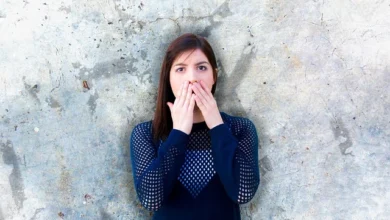10 signs your sweating is hazardous to your health

Sweat is a normal reaction in our bodies to help regulate temperature and lower it when it gets hot.
Our body sweats in response to fever, physical activity, and stress.
Some people suffer from heavy sweating, which occurs even in minor cases. Wet T-shirts and damp palms accompany them regardless of weather conditions or their activity.
Hyperhidrosis or excessive sweating affects about 3-15 percent of people in the world.
Why do we sweat a lot?
Every person needs a sweating function to naturally calm, get rid of excess heat and solid residues, and maintain the body’s salt content.
In total, there are more than 4 million sweat glands on the surface of the human body, which are long, spiral tubes located in the skin.
There are two types of sweat glands:
Eccrine sweat glands
They are found in large numbers on the soles of the feet, palms, forehead, cheekbones, and armpits.
They release a clear, odourless liquid, regulating body temperature and promoting heat loss through evaporation. Most often, with excessive sweating, the eccrine sweat glands are involved.
Apocrine sweat glands
They are found in areas where there are many hair follicles: on the scalp, in the armpits, and the genital region.
When in contact with bacteria on the skin’s surface, they produce a thick liquid with a characteristic body odour.
Both types of sweat glands are triggered by nerves, which in turn respond to different stimuli, including:
- brain messages that the body is too hot
- hormones
- emotion
- physical activity.
In people with heavy sweating or hyperhidrosis, the sweat glands overreact to stimuli and are generally more active, producing more sweat than necessary.
Contrary to popular belief, sweat is not made up of toxins, and we cannot sweat out toxins. Sweat is 99 percent water and small amounts of carbohydrates, salts, proteins, and urea.
Interesting Facts!
- On average, a person has about 200 sweat glands per square centimetre of the skin surface.
- The highest density of sweat glands is found on the surface of your palms and the soles of your feet.
- The human body can secrete 10 litres of sweat per day in the heat or during intense physical exertion.
Excessive sweating: danger signs
In most cases, increased perspiration is not dangerous. Suppose you do not have any other side symptoms, which does not interfere with your normal daily activities. In that case, the problem can be solved by choosing a breathable fabric and an antiperspirant.
However, in rare cases, it can be a symptom of a severe medical condition. There are several signs that sweating indicates a health problem.
1. You started sweating a lot suddenly and unexpectedly
Sudden sweating can be a sign that you are under stress or anxiety. This type of sweat is different from what is produced when your body is trying to cool off, as an adrenaline rush triggers it.
Sudden sweating can also be the first sign of a heart attack or heart problems. If you suspect a heart attack, you should immediately seek medical help.
At the same time, sudden sweating is not always a reason for panic. This is most often associated with specific situations such as fever, spicy food, exercise, or stress.
2. You feel dizzy and light-headed
When sweating is accompanied by dizziness or weakness, it could be a signal from your body indicating low blood sugar or hypoglycemia, which a drop in blood pressure could cause.
While these conditions themselves are not life-threatening, you should see your doctor ensure no cause for concern.
3. Sweating is accompanied by insomnia, facial flushing, chest pain, fatigue, intense thirst and frequent urination
Always look at your overall health to see if sweating is part of a more serious medical condition.
For example, insomnia combined with sweating may indicate hyperthyroidism.
Sweating, along with flushing of the face and chest, can signal carcinoid syndrome, a rare tumour in which certain substances are released into the bloodstream.
If you sweat and have chest pain, this could be a sign of a severe heart problem, and you need to see your doctor urgently.
Fatigue, along with sweating, can indicate infection or low blood pressure.
Finally, intense thirst and urination are often associated with diabetes and blood sugar levels. In this case, a person sweats if their blood sugar drops, signalling stress or tension.
4. You have flu-like symptoms such as high fever and cough
In some cases, sweating with a high fever can signify a bacterial or viral infection, such as malaria or tuberculosis.
Temperature is a consequence of changes in body temperature. Your brain automatically raises the temperature to fight infection, which makes you feel feverish and generate heat. That’s why it’s crucial to bring the temperature down and get a good sweat.
5. You have a skin rash
If sweat stays on your skin, you may experience itching or skin irritation, which will go away as soon as you stop sweating and change into dry and clean clothes. However, problems such as a rash or hives could indicate a fungal skin infection or other medical condition.
There are skin disorders that are associated with increased sweating. For example, cholinergic stress urticaria, in which a rash appears on the skin when the body overheats or sweats a lot. A rash can also occur when you sweat in a hot or humid environment, causing a heat rash or prickly heat.
6. You are experiencing severe stress or panic attacks
Many people sweat during stressful situations, such as public speaking. But, if other symptoms of panic or anxiety accompany sweating, this may indicate a psychological problem.
Anxiety-related sweating can escalate into a vicious circle in which you start sweating from just expecting to sweat. By learning how to deal with anxiety, you can break this insoluble cycle. If you can’t manage your stress on your own, seek professional help.
7. You started to lose weight rapidly
Rapid weight loss and intense sweating may indicate hyperthyroidism. Such symptoms are also characteristic of tuberculosis and mononucleosis, as well as some types of cancer.
If you sweat a lot and your weight is dropping rapidly, it may make sense to see your doctor.
You sweat all over your body, not in certain places
There are two types of hyperhidrosis
Primary hyperhidrosis is excessive sweating in certain areas, such as the armpits, face, or palms.
At the same time, increased sweating throughout the body occurs with various forms of secondary hyperhidrosis.
Certain medications or other medical conditions most often cause this type of sweating. Obesity, gout, menopause, swelling, diabetes, mercury poisoning, diabetes, and hyperhidrosis can lead to intense sweating.
Most of the time, though, sweating all over the body is a normal response to heat, stress, and exercise.
8. You only sweat at night
Many people experience night sweats when it’s hot outside or the temperature in the room gets too high. But, if you keep your home cool, use breathable fabrics and bedding, and still pour out of sweat like a bucket, your health may be at risk.
Night sweats are common with tuberculosis or the flu and can sometimes be a sign of a type of cancer such as lymphoma.
You may also sweat more often at night if you have hormonal changes during menopause or take certain medications.
9. You only sweat on one side of your body
If you notice that sweat appears on only one side of your body, you may need to see your doctor.
Uneven sweating may indicate a rare nervous system disorder called Harlequin syndrome, as well as disorders such as a brain tumour, abscess, or stroke. In rare cases, the cause can be lung cancer and a nervous system disorder – Horner’s syndrome.
While sweating is a lot of discomforts, remember that sweating is perfectly normal for a person.
10. You are sweating for no apparent reason
If you have ruled out all possible diseases and other causes, such as spicy food or physical activity, then most likely, active sweating is simply due to active sweat glands.
Some people have overactive sweat glands, where even the slightest stimulus makes them sweat, indicating a problem.
Recommendations on how to get rid of sweating
Change deodorant to antiperspirant
Deodorant mainly masks the odour, while antiperspirant kills both odour-causing bacteria and blocks the sweat gland ducts that produce underarm sweat.
- Only apply antiperspirant to dry, clean skin.
- Use an antiperspirant at night after showering when your body is more relaxed. This allows the active ingredients to work better.
- Shave under your armpits, as hairs can interfere with the antiperspirant effect, but do not shave just before applying the antiperspirant as this can irritate your skin.
Avoid sweating foods
Some foods make you sweat more.
For example, low fibre foods make your digestive system work harder to break down food.
Foods high in sodium help your body to rid itself of excess salt through increased urination and sweating.
And eating fatty foods warms up the internal organs as the body processes fat.
The most common causes of excessive sweating are foods such as:
- Semi-finished products
- Alcohol
- Garlic and onion
- High-fat foods
- Caffeine
- Spicy dishes.
Eat more foods that reduce sweating
Certain foods can reduce the amount of sweat you produce and soothe over-active sweat glands. Most often, these are foods that do not burden our digestive or nervous system.
These are products such as:
- Foods high in calcium (dairy and cheese)
- Almond
- Bananas
- Milk serum
- High-water vegetables and fruits (watermelon, grapes, melon, broccoli, spinach, cauliflower, bell peppers, eggplant)
- Olive oil
- Oatmeal
- Green tea.
Drink more
When you drink enough water and eat foods that are high in fluid content, your body cools better.
Wear loose-fitting, breathable fabrics
Tight clothing, incredibly close to the underarm area, leads to sweat stains and more profuse sweating. Loose-fitting clothing helps keep you cool and prevents many sweating problems.
Limit your caffeine intake
Caffeine stimulates the nervous system and reduces sweating. It also raises blood pressure, increases heart rate, and activates sweat glands.
If you are a true coffee lover and fan of other hot drinks with a high caffeine content, then this further promotes sweating as it raises your body temperature.
Give up smoking
Nicotine and caffeine raise the body temperature, make the heart beat faster, and the sweat glands work in an enhanced mode. In addition, smoking has been linked to other problems, such as bad breath, yellow teeth, and cancer.




